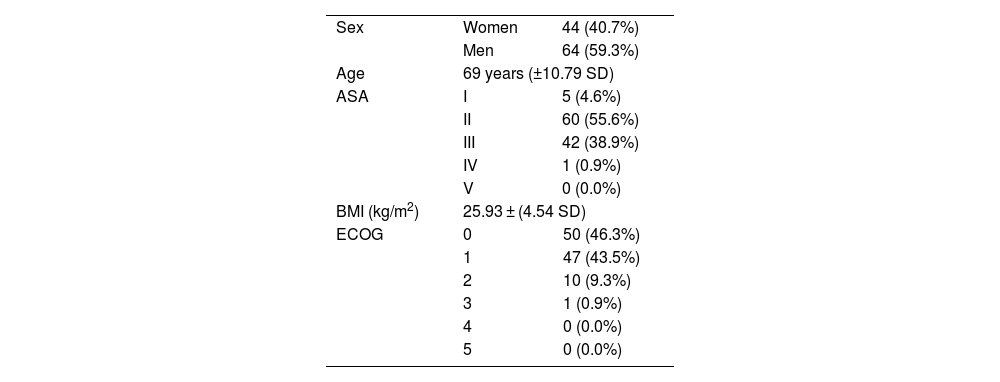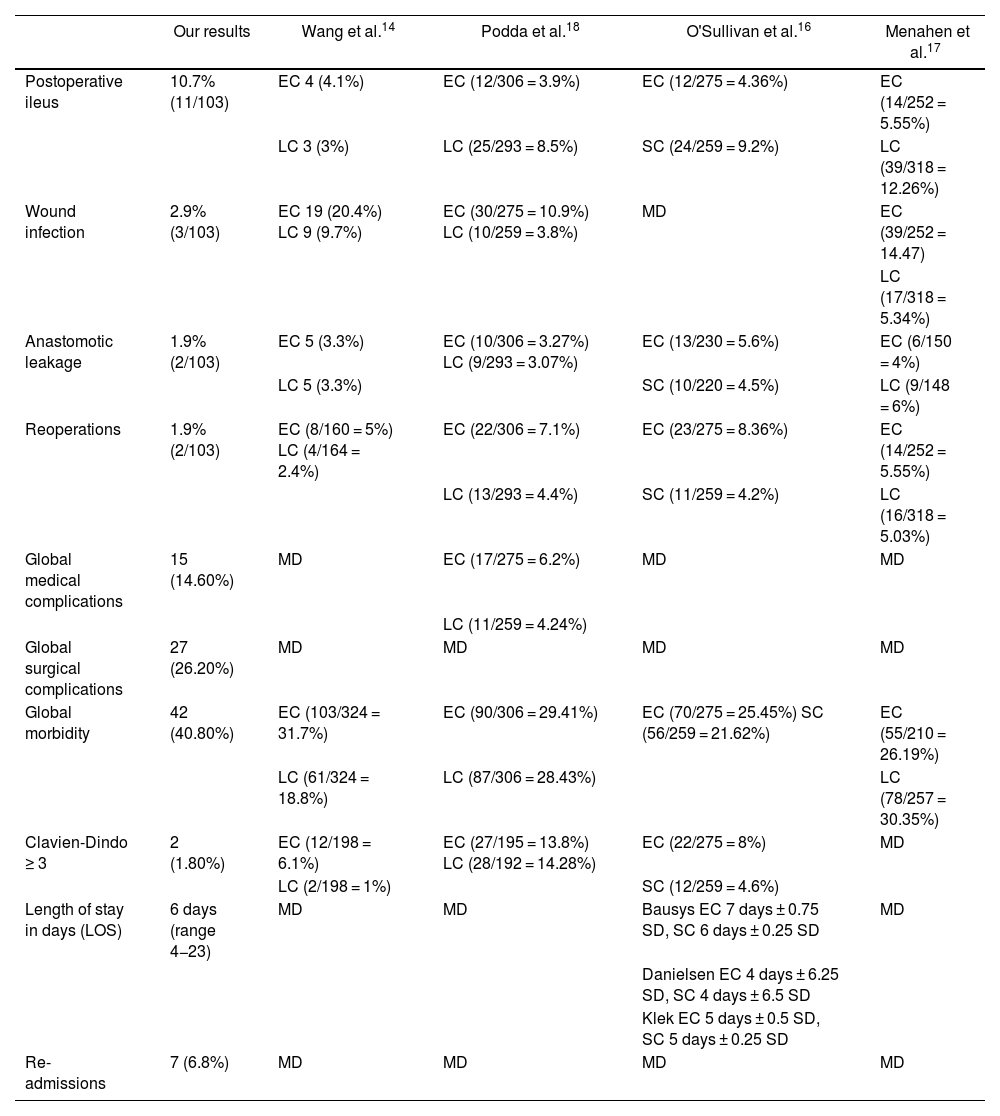To evaluate the clinical outcome of early closure of a protective ileostomy and preoperative stimulation of the efferent limb in a cohort of patients with rectal cancer treated surgically, primarily using the laparoscopic approach.
MethodsWe performed an observational retrospective cohort study in a prospectively recorded series of patients with rectal cancer who underwent laparoscopic surgery with a protective loop ileostomy between 2017 and 2022. Ileostomy closure was programmed for within 3 months after surgery. All patients underwent stimulation of the efferent limb. Primary outcomes were morbidity and mortality, length of stay (LOS), and re-admission.
ResultsBetween 2017 and 2022, 108 patients underwent resection for rectal cancer and protective ileostomy. The laparoscopic approach was performed in 84.3% of patients (n = 91). Permanent ileostomy was performed in 5 patients (4.6%). Ileostomy closure was thus performed in 95.4% of patients (n = 103). Median time to closure was 74.5 days (range 57–113). In 63.1% (n = 65) of patients, reconstructive surgery was performed within 90 days. Prior to closure, efferent limb stimulation was performed in 77.8% (n = 84) of patients. Global morbidity was 26.2% (n = 27) (85.19%, n = 23 Clavien-Dindo I and 7.41%, n = 2 Clavien-Dindo II). The main causes of morbidity were postoperative ileus (10.7%, n = 11) and rectal bleeding (8.7%, n = 9). Anastomosis leakage occurred in 2 patients. Median hospital stay was 6 days (5–7). Readmission was needed in 6.8% (n = 7) of patients.
ConclusionA previous laparoscopic approach, early closure and stimulation of the efferent limb could be a useful strategy to reduce the morbidity and mortality of temporary ileostomy closure.
Evaluar los resultados del cierre temprano de la ileostomía de protección y la estimulación del asa eferente en una cohorte de pacientes operados de cáncer de recto intervenidos inicialmente por laparoscopia.
MétodosEstudio observacional retrospectivo de una cohorte de pacientes afectos de cáncer de recto que han sido intervenidos entre 2017 y 2022 por laparoscopia con ileostomía de protección. El cierre se planteó antes de los tres meses. Todos los pacientes recibieron estimulación del asa eferente. Los objetivos primarios fueron la morbi-mortalidad, la estancia hospitalaria y los reingresos.
ResultadosEntre 2017 y 2022, se intervinieron por cáncer de recto con ileostomía de protección n = 108 pacientes. El 84.3% (n = 91) se realizó por laparoscopia. La tasa de ileostomía permanente fue del 4.6% (n = 5), por lo que se cerraron el 95.4% (n = 103). La mediana de tiempo al cierre fue de 74,5 días (rango 57–113). En el 63.1% (n = 65) la cirugía reconstructiva se realizó antes de los 90 días y la estimulación del asa eferente en el 77,8% (n = 84) de los pacientes. La morbilidad global fue de 26.2% (n = 27) (85.19%, n = 23 Clavien-Dindo I y 7.41%, n = 2 Clavien-Dindo II), siendo el íleo paralítico (10.7%, n = 11) y las rectorragias (8.7%, n = 9) las más frecuentes. La dehiscencia de anastomosis ocurrió en 2 pacientes. La mediana de estancia hospitalaria fue de 6 días (rango 5–7). Reingresó el 6.8% (n = 7) de los pacientes.
ConclusiónEl abordaje laparoscópico previo, el cierre temprano y la estimulación del asa eferente podrían considerarse las tres estrategias para reducir la morbi-mortalidad en el cierre de la ileostomía de protección.















